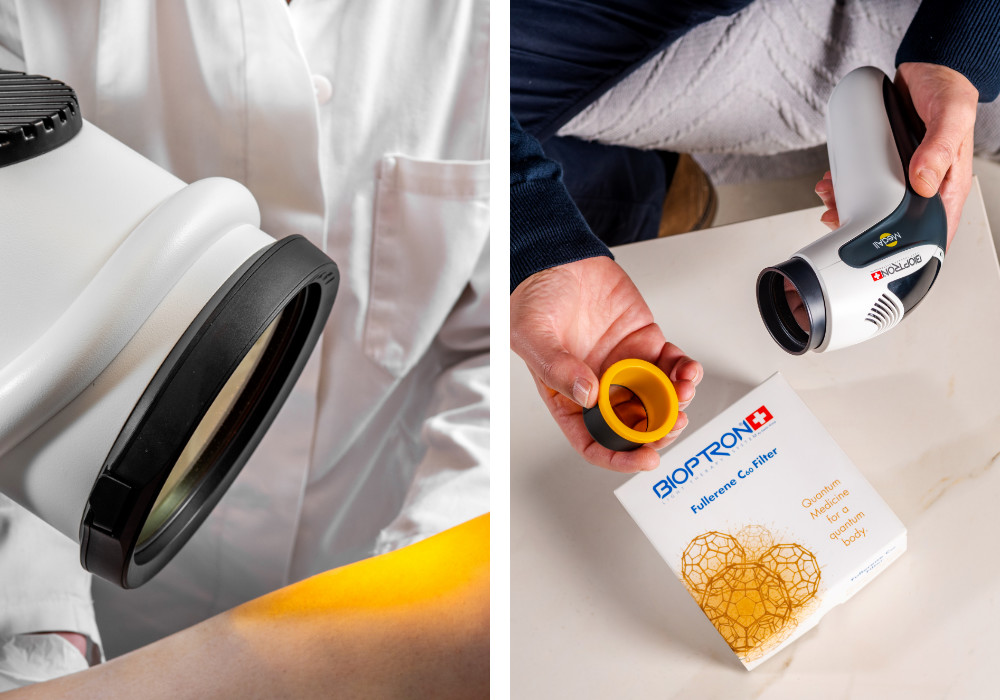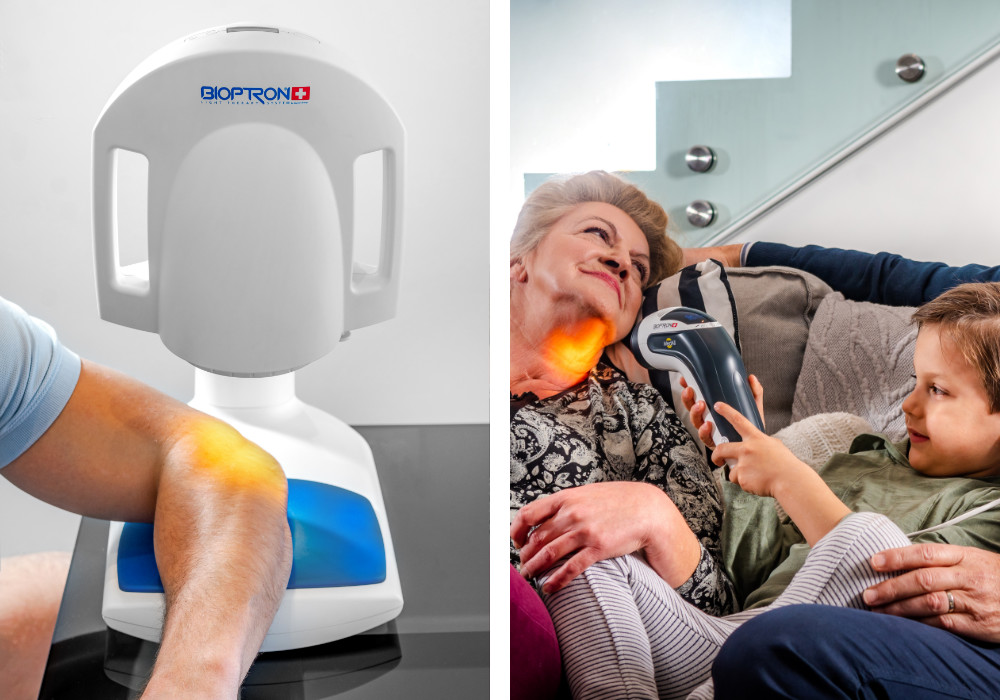SCIENTIFIC APPROACH
BIOPTRON HYPERLIGHT THERAPY FEATURES:
- Brewster’s Optical Unit
- Bioptron polychromatic light
- Bioptron low energy light
- Bioptron incoherent light
- Bioptron vertically linearly polarized light
- Bioptron hyperpolarized light

BREWSTER’S OPTICAL UNIT
The high-quality Brewster’s Optical Unit, a multi-layered optical system, is positioned at a specific angle in the BIOPTRON device. When the diffuse / unordered – non-polarized light from the BIOPTRON light source is incident on the Brewster’s Optical Unit, it is reflected and becomes (with minimal reflection loss) entirely and perfectly Vertically Linearly Polarized.

POLYCHROMATIC LIGHT
BIOPTRON generates light in the visible spectrum as well as a portion of infrared wavelengths, ranging from 480 nm to 3400 nm, that is 1.15 - 2.90 eV (with a pronounced peak at 720 nm, 1.70 eV) ) allowing the light to penetrate deep through into tissue, activating and promoting various cellular and biological processes that accelerate regenerative and reparative healing processes.

BIOPTRON INCOHERENT LIGHT
Out-of-phase or unsynchronized light is characterized by light waves that are not temporally or spatially synchronized. Frequent and random changes of phases between photons of light of different wave frequencies and wavelengths make this a low-intensity light.
BIOPTRON incoherent light promotes safe, noninvasive and effective healing without the risk of developing resistance to the therapy. In contrast to this, most laser lights have a high intensity, coherent light which has a high potential for tissue damage.

BIOPTRON LOW ENERGY LIGHT
BIOPTRON delivers a consistent stream of light with a steady intensity (also known as power density) of 40 mW/cm2 at a distance of 10 cm from the treated area. The dosage of BIOPTRON light can be precisely determined, as the BIOPTRON light has two components, power and time: Energy (J) = Power (W) × Time (s) (the Bunsen-Roscoe rule of reciprocity in photobiology).
In other words, if power is doubled and exposure time halved, the same amount of energy will be delivered, but very different biological responses will be achieved and observed. BIOPTRON delivers a dose of light equivalent to an average energy density of 2.4 J/cm2 per minute. This represents a low and safe dosage of light that stimulates natural healing with no side effects.
BIOPTRON VERTICALLY LINEARLY POLARIZED LIGHT (VLPL)
When diffuse light emitted by a halogen bulb collides with and reflects off the Brewster Optical Unit, this light becomes vertically linearly polarized with waves that propagate in vertical parallel planes in one direction. Unlike diffuse and laser light, BIOPTRON VLPL acts not only on molecules based on their absorption characteristics, but acts efficiently on the structure and organization of biological processes, molecules and tissues and therefore has a significantly better healing effect.
All biological structures in their normal functional state are linearly arranged (such as liquid crystals, collagen, microtubules, lipids in membranes, internal mitochondrial arrangement and linear organization of dipole moments of water). When biological processes are disordered, due to its linear organization, VLPL returns them to their optimal functional state.
Essentially, in addition to polarization, BIOPTRON provides an optimum choice of light spectrums and light energy in time, necessary for the treatment of many medical conditions. The explanation of such a profound effect of the BIOPTRON phenomenon, among other things, lies in the fact that 85.5% of all molecules in the human organism are water molecules (made up of hydrogen and oxygen atoms), and that each one of them has a particular function in the body.

BIOPTRON HISTORY
THE INVENTION
The Danish physician Niels Ryberg Finsen (pictured) founded modern light therapy about 100 years ago. In 1903 he was awarded with the Nobel Prize in medicine for his achievements with light therapy. Finsen created the first device to generate technically synthesized sunlight and achieved outstanding results in the treatment of patients suffering from a special type of skin tuberculosis.

DEVELOPMENT OF BIOPTRON LIGHT THERAPY
At the beginning of the development of photo medicine mostly infrared and ultraviolet parts of the spectrum were used in modern light therapy. In the early 1980s, a research team of scientists created a light source that was originally based on low-level laser therapy but actually worked with almost the whole range of visible light and a portion of infrared light. The research revealed certain physical characteristics that are essential for the effectiveness of light therapy. Based on this technology later the BIOPTRON Light Therapy System was created.
BIOPTRON AG is working continuously with experts, researchers and physicians in many countries in order to examine the characteristics and therapeutic effectiveness of BIOPTRON Hyperlight Therapy.



CERTIFICATES
BIOPTRON AG - ASSURING TOP QUALITY
BIOPTRON AG in-house laboratories are constantly engaged in testing and optimizing BIOPTRON devices according to the latest scientific studies carried out by independent institutions.
Simultaneously, BIOPTRON devices are further certified by accredited independent testing institutes. Our business processes, including R&D, supplier evaluation, the supply of components to production, ongoing inspections and the product itself, fulfill all expected regulations according to the European Community medical device directive 93/427 EEC, as well as particular national regulations of the local markets.








